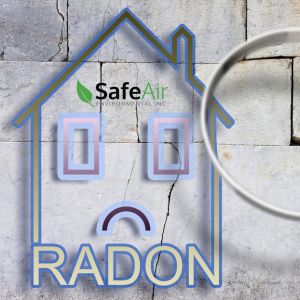What Causes Spikes in Radon Levels
Posted in Radon Testing, on October 26, 2023
In an average month, your home may not test positive for elevated levels of radon gas due to several shifting factors — but that may not eliminate your risk. This fluctuating risk is why SafeAir’s radon detection services happen over months, not weeks, and why professional radon detection is essential for monitoring your indoor air quality. There are several different ways that radon gas can enter your home, and as the seasons shift, these points may cause more or less radon gas into a building.
 Here are four of the primary methods radon gas gets indoors.
Here are four of the primary methods radon gas gets indoors.
Sources of Radon
- Soil: Radon gas comes from deep in the earth’s crust, where it’s produced by decaying uranium. Homes with natural earth basements or crawlspaces often have radon spikes throughout the year because of this lack of barrier between your interior spaces and the exterior.
- Cracks and Gaps: Even if you have a floor or foundation wall between your basement and the earth, radon gas can still sneak in through cracks and gaps that form as your foundation ages. The easiest way to solve this problem is to fill any visible cracks as soon as you notice them.
- Rocks: Many types of stone used in home finishing may contain trapped radon gasses that will off-gas once in your kitchen or bathroom. Another source of radon gas from rock is on properties built directly onto natural rock outcroppings.
- Well Water: Radon gas can enter water sources, gaining entry to your home’s indoor air environment through taps, toilets, and drains. For inner-city clients, this isn’t a problem — but if you have a well, installing a radon capture device at the source can eliminate this issue.
How To Minimize the Threat of Radon
The first step to minimizing the threat of radon gas to your indoor air quality is to know what you’re facing — each home will have unique factors that affect how much (if any) radon gas is entering your property. The best way to do this is through radon testing with SafeAir. We’ll carefully place a small device in your home’s lowest level (usually the basement) that passively monitors radon gas for 3-6 months.
This time frame may sound long, but it is necessary to help even out the curve caused by fluctuations and spikes in radon gas throughout the seasons. Weather, temperature changes, and activity inside your home can all affect radon gas concentration.
How SafeAir Can Help
The real work comes after we complete our radon testing. We send the testing device to a third party laboratory for analysis. Coupled with our experience with home inspection, we’ll help you understand these results, locate where the radon might be entering, and what you can do to eliminate or mitigate your risk. For many homeowners, the changes will be minor, like fixing cracks and gaps in the foundation or installing sump pump covers. Properties with higher radon gas concentrations may need more extensive remediation plans, but minor adjustments make a big difference for most people.
To learn more about radon detection for your home, contact SafeAir today!

